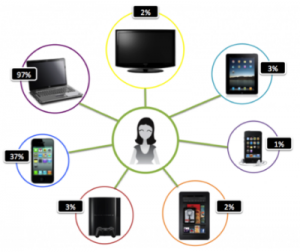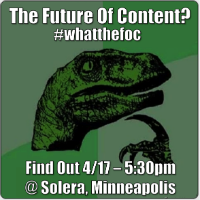
Future of Content – Retro image from Shutterstock
It’s a pretty compelling question: What is the Future of Content? What’s in store for content marketing?
With the growing adoption of brand publishing and convergence of paid, owned, earned and shared media, many companies are looking forward to what’s next. In retail, Multi Channel is now Omni-Channel and single format storytelling has evolved into Transmedia Storytelling. Computers are becoming the fax machines of internet connected devices as smart phones, tablets and laptops become the norm.
To answer the question about the future of content, I think it’s important to think about the relationship of information, technology and the human experience with content.
A good place to start is understanding how your target audience discovers, consumes and acts on information. I believe an effort towards empathizing with the consumer information journey provides the essential cues for meaningful content marketing planning, promotion and performance optimization.
Discovery
Good content planning considers audience characteristics in the context of the business. In addition to that, it makes sense to dig into discovery channels, whether they be ads, email messages, search keywords, topics on social networks, popular websites and other places where digital information is most likely to occur for your target audience. Marketers must think in terms of how to be the “best answer” for what it is that consumers want, everywhere they may be looking.
Ann Handley, Chief Content Officer at MarketingProfs says:
“Finding has been around for a long time — in the age of Google, you can expect that people will search for your business online. But as social platforms expand and adoption increases, sharing is far more prevalent AND important. That’s the secret to successful content, too: Creating content worth sharing, because increasingly social networks recommendations are as powerful (actually, more so) than Google results.”
On today’s search and social web, discovery is intertwined with experience and sharing, which leads to more discovery. Making content easy to find, wherever your audience is looking, as well as easy to share is the standard today. But most companies are still playing catch-up to that standard. The future of discovery means an investment in meaningful content and optimizing the visibility of that content where it matters most.
Consumption
Optimizing user experience means more than the ideal page layout and calls to action to increase conversions. Not every visit to your information will result in a sale. But the information consumption will be an experience of some sort. The question is, will it be an experience that’s memorable and worth sharing?
Content format preferences can be key, so it’s important to figure out how your target audience prefers to consume information: whether it’s video, visuals like infographics, long or short form text, or the many other media formats that exist. Topics and stories matter too, not just the media used to tell them.

Also look at what devices and platforms people are using to consume the information – social networks, websites, blogs, apps, and games plus smartphones, tablets or computers. Computer sales are rapidly declining and more people now buy more smartphones than any kind of computer. Is that trend reflected in your own customers’ journey?
Tapping into web analytics for devices used and media types consumed that results in conversions is the low hanging fruit for determining whether you need to optimize for a mobile experience vs. tablet or images vs. video. The same goes for themes, topics and stories that result in reaching content consumption objectives, whether they be time on site, page views, social shares or sales.
It’s not enough to create more content on the web. Companies need to look at creating compelling content that contributes to a memorable and compelling customer experience wherever they may be. The trend towards transmedia storytelling, borrowed from the entertainment industry, is a reflection of this shift. In retail, Omni-Channel marketing is the direction companies are taking to be wherever the consumer lives and to give them an experience worth inspiring purchase and sharing.
Michael Brenner, Vice President of Marketing and Content Strategy at SAP says:
The future of content is human. Emotional. Personal. Until now, most content marketers have been focused on utility and publishing practical value through things like presenting data in infographics, lists and “how to” tips. I think this kind of content serves as a foundation. There will always be a need for this. But to differentiate themselves in the future, successful brands will be telling stories that evoke strong emotions and help the brand make a personal connection with their audience. One great example of this is the Google Chrome commercial “Dear Sophie.”
Action
Creating compelling content where your customers are looking and in the formats they prefer is where a lot of companies stop. But taking the next step and optimizing for action (not just sales conversions) is essential to positively affect business outcomes and to meet consumer expectations. Not every interaction with your content will result in a sale, but if it resonates with the reader or viewer, then providing alternative actions will help guide the consumer closer to the transactional objective the brand desires.
Lisa Grimm, Director, PR and Emerging Media at space150 says:
“Content, its present and future, is about storytelling. The result of which being a shared experience with meaning that prompts an action or outcome. Storytelling relies on the audience to develop specific visual imagery and detail to complete and co-create the story. Digital and social media enable us to create rich dialogue and dynamic communications experiences through the creation and distribution of content, and the conversation it precipitates.”
The future of content is most meaningful in the context of your brand’s experiences with your customers. Those experiences must also be accountable to meeting customer needs and contributing to business performance.
Joe Pulizzi, founder of Content Marketing Institute, Content Marketing World and Chief Content Officer Magazine says:
Content is: Compelling content that informs, engages or amuses. What makes content marketing different than simple content is that content marketing must do something for the business. “…with the objective of driving profitable customer action.”
What I’d challenge you to do is think about answering this question for your company and your customers. What is the future of content for your customers and community? Answer that and I think you’ll be a lot further ahead to answering what the future of content is for your own brand and even yourself.
 If you’re in the Twin Cities this week, join me downtown Minneapolis at Solera on Wed, April 17th at 5:30pm for a MIMA presentation on this topic: The Future of Content.
If you’re in the Twin Cities this week, join me downtown Minneapolis at Solera on Wed, April 17th at 5:30pm for a MIMA presentation on this topic: The Future of Content.
Here’s the official description:
According to IBM, 90% of the data in the world today has been created in the last two years. Once you sift through the porn, pregnancy announcements, unfortunate health-condition disclosures and cat videos, you’re faced with a deluge of information produced by brands and their consumers.
As the traditional publishing model evolves, the door is open for brands to wield even greater influence over reporting and consumer information-discovery. However, taking advantage of this opportunity necessitates understanding the future of content.
Join Lee Odden at Solera on Wednesday April 17 for a discussion on the future of content, trends and how content is organized in successful organizations.
Get more info on the MIMA site and follow the hashtag #whatthefoc on Twitter.
Update: Here is the full video of the MIMA Future of Content for Marketers presentation:
What are your predictions on the future of content?


